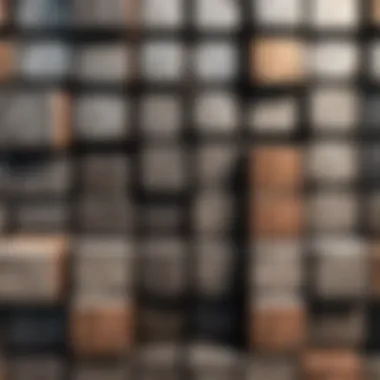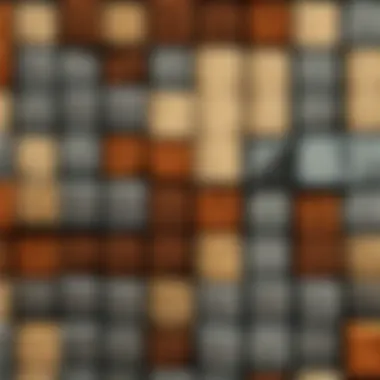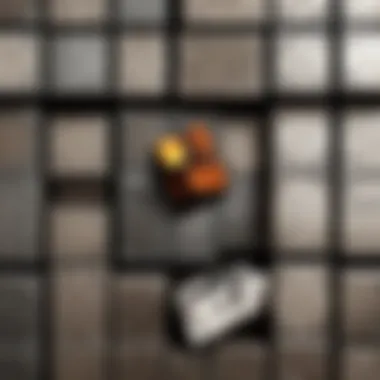Understanding the Importance of Iron Blocks in Minecraft


Intro
In the vast pixelated world of Minecraft, players constantly seek resources that not only serve functional purposes but also elevate their gameplay. Iron blocks stand out as a vital component, often overlooked by those new to the game. These blocks, formed from the humble iron ingots, are essential for various applications, ranging from construction to complex redstone machinery. Understanding their roles can significantly enhance a player's effectiveness in survival and creativity.
Iron blocks are more than just a building material; they come packed with strategic benefits and are integral to several in-game mechanics. By exploring their attributes, crafting methods, and innovative uses, players can unlock more advanced gameplay techniques. This guide aims to paint a vivid picture of why iron blocks are indispensable and how they can transform an ordinary gaming experience into an extraordinary one.
Intro to Iron Blocks in Minecraft
Iron blocks serve as significant structures in Minecraft, standing as a testament to a player's achievements and resource management in the game. Not only do they enhance the aesthetic appeal of builds, but they also play crucial roles in various gameplay mechanics. By delving into the properties, crafting processes, and strategic applications of iron blocks, players can fully understand their value in the Minecraft universe.
Basic Properties of Iron Blocks
Iron blocks, crafted from nine iron ingots, are durable and robust, offering impressive properties. Here are some key features:
- Durability: Iron blocks are resistant to explosions and have a relatively high blast resistance, making them a dependable choice for building defensive structures.
- Versatility: They can be used in a range of applications from architectural elements to practical redstone contraptions.
- Mining: When mined, they drop themselves, making them a resourceful building material compared to other block types that dissipate into their basic components.
Their sleek metallic sheen sets them apart aesthetically, contributing to a wide variety of artistic and functional designs.
Iron Blocks vs. Other Block Types
When comparing iron blocks to other types of blocks in Minecraft, several distinctions become apparent:
- Strength and Durability: While many blocks serve general building purposes, iron blocks excel in providing durability. Other types, such as wood or even stone, do not offer the same level of protection against creepers or explosions.
- Crafting Requirements: Iron blocks require multiple iron ingots, which can be more resource-intensive than crafting simpler blocks, but their advantages often justify the investment.
- Conductivity: Unlike wood, iron blocks can conduct redstone signals, making them essential for advanced redstone projects. This offers players unique opportunities for innovation in device creation.
"Choosing the right block can often determine the outcome of a strategy, be it building a fortress or creating an intricate machine."
Overall, understanding the properties and strategic advantages of iron blocks is crucial for players aiming to deepen their gameplay experience in Minecraft. With their robust nature and versatile applications, iron blocks undoubtedly hold a core place in the Minecraft builder's toolkit.
Crafting Iron Blocks
When it comes to Minecraft, one of the fundamental features that players must grasp is the crafting process. Iron blocks are iconic for their versatility and function within the game. Crafting iron blocks is not just about gathering materials and using a crafting table; it’s about recognizing the value that these blocks bring to your gameplay. From providing robust structural support to enabling complex redstone mechanics, iron blocks are essential in any player’s toolkit. Understanding the crafting process allows players to optimize resource management and expand their creative expressions within the game.
Required Materials
To craft iron blocks, players need specific materials on hand. Here’s a straightforward breakdown of what you’ll require:
- Iron Ingots: The primary material needed. Each iron block requires nine iron ingots. These ingots are obtained by smelting iron ore in a furnace.
- Crafting Table: While you can craft a single iron ingot using a 2x2 crafting grid, an iron block necessitates a crafting table for the 3x3 grid arrangement.
Gathering iron ingots can take some effort, but it’s well worth the investment when you consider the impressive benefits of iron blocks.
Step-by-Step Crafting Guide
Once you have your iron ingots ready, the actual crafting process is deceptively simple. Follow these steps to create iron blocks:
- Access a Crafting Table: If you haven’t made one yet, you can craft a table using four wooden planks. Open the crafting menu.
- Arrange the Iron Ingots: In the crafting table interface, fill all nine slots with iron ingots. The layout should resemble this:| Iron Ingot | Iron Ingot | Iron Ingot | | Iron Ingot | Iron Ingot | Iron Ingot | | Iron Ingot | Iron Ingot | Iron Ingot |
- Collect Your Iron Block: Once the arrangement is correct, an iron block will appear in the result box. Drag it into your inventory.
- Repeat as Necessary: If you have more ingots and need additional blocks, simply repeat the process.
Crafting iron blocks may seem like a trivial task, but recognizing their strategic advantages can significantly enhance your Minecraft experience. Whether you’re using them for structural integrity, a decorative element, or in complex redstone projects, mastering this crafting technique lays the groundwork for advanced gameplay."A well-crafted block isn't merely a building material; it's a canvas for creativity and utility in the vast realm of Minecraft."


Uses of Iron Blocks
Iron blocks have carved a substantial niche in the sandbox world of Minecraft. They embody more than just a storage solution for iron ingots; their applications stretch across a myriad of gameplay elements that enhance both functionality and aesthetics. The importance of these blocks cannot be overstated—be it for structural integrity or powering intricate mechanisms, their role is vital to a player's toolkit. Unpacking the myriad uses of iron blocks reveals how they contribute fundamentally to the gaming experience, making them a cornerstone for both novice and experienced players alike.
Structural Applications
When it comes to constructing buildings or fortifications, iron blocks lend an air of resilience and prominence. They stand out visually and substantively, making them a favored choice for players keen on creating sturdy structures that can withstand the elements and enemy attacks. For instance, a castle adorned with iron block walls not only showcases a player's craftsmanship but also offers practical protection.
Additionally, iron blocks can bear heavy loads and resist explosions better than many alternative materials. This ability is particularly crucial in survival mode, where the threats from Creepers and other foes are real enough to keep players on their toes. Their durability means that structures can last longer without the need for constant repairs, a strategic advantage when resources are tight.
"With iron blocks, you're not just building; you're fortifying your dreams in the cubic world!"
Moreover, the reflective nature of iron blocks allows them to add a unique aesthetic element to builds. When used in creative projects, they can symbolize strength and permanence. Players often incorporate them into architectural marvels like bridges, statues, and even decorative pieces that communicate the theme of their world.
Redstone Mechanisms
Iron blocks play an integral role in the realm of redstone engineering. These blocks are often employed in complex contraptions and machines, serving as both components and a medium of connection. Understanding how they interact with redstone is key to mastering some of the more sophisticated mechanics in Minecraft.
Integration with Redstone
The integration of iron blocks with redstone circuits is both straightforward and remarkable. Iron blocks can transmit redstone signals, making them reliable components for a variety of machines and traps. This capacity to support redstone signal flow illustrates one of their key characteristics: versatility.
While some players opt for less impactful materials, the robustness of iron blocks makes them a preferred choice. For instance, when creating a redstone-powered door, using iron blocks helps to ensure that the door operates correctly and withstands external assaults. Their ability to maintain signal strength over distances can also simplify the wiring process, minimizing clutter without sacrificing efficiency.
However, it’s worth noting that while iron blocks are excellent for these purposes, they can be resource-intensive to obtain, which could pose a challenge for players just starting their redstone journey.
Creating Complex Machines
Creating complex machines in Minecraft can elevate gameplay to levels of engineering artistry. Iron blocks frequently serve as the building blocks of these sophisticated contraptions. Players have made everything from automatic farms to massive roller coasters using iron blocks in tandem with redstone.
The unique feature of crafting complex machines is that they often require reliable and durable components, and iron blocks fit the bill perfectly. The solidity they provide ensures that machines remain functional even under stress or during combat scenarios. This reliability makes them a staple in gaming strategies where redstone mechanics are employed.
On the downside, these machines can sometimes become cumbersome, especially if players have not mastered the intricacies of redstone mechanics. Nevertheless, the reward of engineering something substantial from iron blocks is often well worth the initial learning curve.
Mining and Resource Management
Understanding mining and resource management is crucial for any player aiming to optimize their gameplay in Minecraft. Iron blocks serve as a fundamental component in crafting and construction, making effective mining and resource handling a priority. When managed well, not only do they provide solid building materials, but they also contribute significantly to crafting a variety of essential tools and machinery. A strategic approach allows players to streamline their resource acquisition, reducing downtime and increasing efficiency in the game.
Mining Iron Ore
Mining iron ore can sometimes feel like looking for a needle in a haystack, but it doesn't have to be that way. Choosing the right tools and adopting solid strategies can turn iron ore hunting into a straightforward task.
Best Tools and Strategies
When it comes to mining iron ore, a stone pickaxe or better is a must. This tool effectively breaks iron ore blocks, allowing players to collect the precious resource without wasting durability. Using a pickaxe enchanted with Efficiency can speed up the mining process significantly.
Another beneficial strategy is to mine in layers. By digging horizontally at different levels, players can expose more ore blocks. As a useful tip, many players find iron ore tends to cluster in veins, typically below level 64. To enhance the efficiency of mining, players can carry a water bucket to remove lava pools quickly or keep torches handy to light up dark areas, preventing mobs from interfering.
In summary, the key characteristic of using better tools and effective strategies in iron mining is their contribution to higher yield and reduced effort. However, players should remember that juggling between speed and resource management is essential to avoid exhausting materials too quickly.


Location Tips
Knowing where to mine is half the battle won. It's essential to target areas where iron ore generates more frequently. Iron usually appears in mountain biomes, mesa biomes, and caves. While the typical depth for iron is between levels 1 and 63, players are more likely to strike gold—figuratively speaking—by scouting elevated mountain terrains or exploring deep caves.
Consider branch mining as a technique. By digging down to level 12 and then creating branch tunnels at regular intervals, players can maximize ore exposure with minimal wasted resources. Another unique feature of location tips is the utilization of the F3 key on Java Edition, which gives players biome and coordinate information to assist in directing their mining efforts. This method may lessen the guesswork and increase the chance of finding iron quickly.
All in all, making informed choices about where to mine relates directly to optimizing iron resource management in the game.
Effective Resource Handling
Now that players are equipped to mine iron ore effectively, managing those resources becomes vitally important. A piece of iron ore can be a stepping stone to producing multiple important items, from tools to blocks.
To begin with, players should build a furnace as soon as possible. Smelting iron ore rather than leaving it raw allows for more versatile applications. A blast furnace is even more efficient, smelting iron twice as fast, allowing users to progress quickly while putting their resources to good use.
Keeping an inventory system is another intelligent way to manage resources. Players should use chests to categorize resources: one specifically for iron ingots, another for tools, and so forth. This keeps the inventory organized and ensures users can quickly find materials when needed.
"In the world of Minecraft, tailored resource management is often the difference between struggling on survival mode and sailing through with ease."
Combining these management techniques can lead to significantly better game play; this organization aids in planning for future projects, reduces the risk of running out of essential materials, and ensures players can maximize their crafted items. With coal and iron working hand in hand for torches and tools, staying prepared by keeping resources well-managed allows players to focus their energy on exploration and creativity.
Strategic Advantages of Iron Blocks
Iron blocks are not merely a building material in Minecraft; they come with a unique set of strategic advantages that can significantly impact how a player navigates through the game. Understanding these benefits can elevate your gameplay from average to exceptional, whether you’re redecorating your base or gearing up for battle. Let's break down what makes iron blocks indispensable.
Durability and Strength
Iron blocks boast impressive durability, making them one of the most robust block types available in Minecraft. With a hardness rating of 5, they can withstand various forms of damage quite effectively. This durability makes them ideal for constructing secure bases. Since they cannot be destroyed by most explosions, using iron blocks in your defenses can deter creepers and other hostile mobs.
Moreover, while wood and stone may crumble under pressure, iron blocks stand the test of time. This resilience pairs well with another trait: their blast resistance, which is higher than that of many other materials. One useful tip to remember, though, is that while their strength is commendable, it’s their ability to combine with other components that truly makes them formidable. Consider building traps or hidden entrances using iron blocks as foundations—this creates a secure layer that intruders will need to work harder to breach.
Benefits in Combat Scenarios
In combat, iron blocks can serve more than just an aesthetic purpose. For starters, they can help create safe zones during confrontations with hostile mobs or players. When you find yourself overwhelmed in a tight spot, placing iron blocks around you can give you the upper hand. Not only can they absorb damage, but they also provide a moment of reprieve to regroup or plan your next step.
Additionally, if you're into crafting intricate Redstone contraptions, iron blocks can act as a sturdy base for various mechanisms. Imagine setting up a hidden trap in your base by utilizing iron blocks as the key structural component. When someone triggers a hidden lever, the block gives way, and voila! Your foes are caught off-guard, leaving them to wonder what hit them.
- Iron blocks can:
- Enhance your defensive structures.
- Protect from explosions and environmental damage.
- Serve as a vital component in combat traps and Redstone mechanisms.
"Iron blocks are the unsung heroes of secure bases and tactical warfare in Minecraft. They are much more than just a pretty façade."
Overall, iron blocks’ durability and unique applications in combat scenarios make them an essential resource in your Minecraft toolkit. Missing out on their strategic advantages could mean the difference between survival and defeat.
Design Inspiration Utilizing Iron Blocks
When it comes to Minecraft, creativity is a core aspect of the gaming experience. Among the myriad of blocks available, iron blocks stand out not just for their utility but also for their potential in design. Players of all skill levels can find their inspiration in iron blocks, whether it’s for building sturdy structures or crafting intricate art pieces. This section explores the breadth of possibilities iron blocks offer, along with the unique considerations that come with their use in design.


Architectural Features
Iron blocks are an excellent choice for architectural projects in Minecraft. Their sleek, metallic texture enhances the aesthetic appeal of buildings. Here are some notable architectural applications:
- Support Structures: Iron blocks provide exceptional durability. Used as a support beam in skyscrapers or bridges, they can make your creations not only look modern but also be fortified. This aligns well with the game’s physics, giving players a sense of realism in their builds.
- Facades and Detailing: The shiny surface of iron blocks can be used cleverly to create stunning facades. For example, incorporating iron blocks in the walls of a castle or a fortress can signify strength and security. Additionally, they can be used to create intricate patterns, giving a blocky yet sophisticated feel to your design.
- Lighting Elements: By combining iron blocks with glowstone or lanterns, players can achieve impressive lighting effects. The reflective properties of iron can make structures shimmer in the dark, enhancing the nighttime beauty of your creations. Setting up an iron block frame around a lit area can simulate a modern street lamp.
"With iron blocks, you’re not just building; you’re crafting a statement. The metallic glow adds a sense of sophistication that wood or stone can’t match."
Artistic Creations
Beyond practical architecture, iron blocks unleash a realm of artistic potential. Players can use these blocks to express creativity through various artistic mediums:
- Sculptures: Creating sculptures from iron blocks allows players to experiment with shapes and forms. From abstract art to recognizable objects, the sturdy nature of iron blocks makes them a reliable choice for outdoor installations. Their rigidity means they can uphold their form without collapsing.
- Mosaics and Patterns: By mixing iron blocks with other materials, players can design mesmerizing mosaics. The contrast between the raw strength of iron and the softer tones of other materials like wool or clay can add depth to designs. This is especially effective in public squares or courtyards, where intricate designs can draw attention.
- Interactive Art: Combining iron blocks with Redstone can lead to interactive artistic inventions, like moving statues or light displays. This makes art in Minecraft not just a visual experience but also a dynamic one, captivating viewers as they engage with the pieces.
Utilizing iron blocks in design can transform ordinary builds into extraordinary expressions of creativity, paving the way for an engaging experience that showcases both architectural skill and artistic flair. Players are encouraged to think outside the box, or, in this case, outside the block!
Future Considerations and Updates
Understanding the future considerations and updates around iron blocks in Minecraft is not just a matter of keeping up with the game; it’s about anticipating how these changes might impact players’ strategies and overall gameplay. As the game evolves, iron blocks, being a foundational element, are likely to see adjustments that could enhance functionality, introduce new crafting possibilities, or alter existing mechanics. Keeping an ear to the ground on these potential changes helps players adapt swiftly, maintaining their edge in a constantly shifting environment.
Potential Changes in Game Mechanics
The dynamics of gameplay in Minecraft are influenced significantly by updates. Potential changes in the mechanics surrounding iron blocks could revolve around several key elements:
- New Crafting Recipes: Updates might introduce more ways to utilize iron blocks, such as combining them with other materials to create advanced machinery or decorative blocks.
- Alternate Uses in Redstone: If Mojang decides to enhance the interaction between iron blocks and redstone components, players could unlock new mechanisms or traps that weren't possible before.
- Durability Adjustments: Changes in how durable iron blocks are, or introducing wear and tear, could lead players to rethink their structural designs or usage in constructs.
- Environmental Integration: There’s also the possibility of integrating iron blocks more closely with the biomes or the environment, such as changes that might connect the functionality of iron blocks to specific materials found in certain regions.
In essence, staying informed about these shifts ensures players can pivot their strategies effectively, guaranteeing that they make the most of iron blocks in light of new mechanics.
Community Feedback and Adaptations
Community reaction has always played a monumental role in shaping Minecraft. Player feedback has the power to influence which features are prioritized in updates. The discussion surrounding iron blocks is no different:
- Request for New Features: Players frequently voice their desire for further applications of iron blocks, which could lead to developers integrating these various suggestions in patch notes, ensuring that the block remains relevant.
- Player-Driven Innovations: Often, players design creative uses for iron blocks that may be adapted into official game updates, showcasing community ingenuity. For instance, if players discover a unique redstone circuit leveraging iron blocks, similar mechanisms might be incorporated into future gameplay.
- Balancing Changes: If it is found that iron blocks provide an unusually high advantage, the community may advocate for balance changes through forums or social media platforms like Reddit. This engagement fosters a sense of collective ownership of the game and ensures a balanced play experience for all.
"The pulse of the Minecraft community beats strongest in its feedback; it's an organic conversation between players and developers that shapes the future of our blocks."
Ultimately, the landscape of Minecraft is constructed on two pillars: the active player community and the responsive developers at Mojang. Iron blocks not only serve traditional purposes but also stand at the frontier of innovative modifications that could redefine their significance in the game.
Culmination
The role of iron blocks in Minecraft extends beyond mere decoration; they embody a synergy of utility, resilience, and versatility that significantly influences gameplay. A deeper understanding of iron blocks allows players to leverage their functionality effectively, providing a solid foundation upon which diverse architectural and mechanical creations can be established.
Recap of Iron Block Attributes
Iron blocks boast several key attributes that make them indispensable in the world of Minecraft. To sum up:
- Durability: With a hardness level of 5 and immunity to explosions, iron blocks are remarkably tough. This ensures safety, especially in PvP environments where every detail can tip the scales between victory and defeat.
- Crafting Component: As a fundamental material in constructing various items, including powered rails, beacons, and anvil, iron blocks serve as a linchpin in a myriad of creations.
- Aesthetic Appeal: Iron blocks have a sleek, metallic look that lends itself well to modern design schemes within builds. Their neutral shade can complement other materials, creating a cohesive visual narrative.
Final Thoughts on Their Importance in Minecraft
They are essential for both novice and expert players alike. Veteran players would agree that the versatility and reliability of iron blocks make them a frequent go-to choice when planning complex builds or intricate mechanisms. By exploiting their properties, players can construct elaborate structures or reliable machines that enhance efficiency, making the journey in Minecraft that much richer.
"In Minecraft, where creativity knows no bounds, the significance of iron blocks cannot be overstated. They form the building blocks of innovation."
Thus, the next time you mine some iron ore or craft an iron block, consider the vast array of possibilities that lie within. Iron blocks hold promise, adding depth to your Minecraft journey by marrying form with function.



